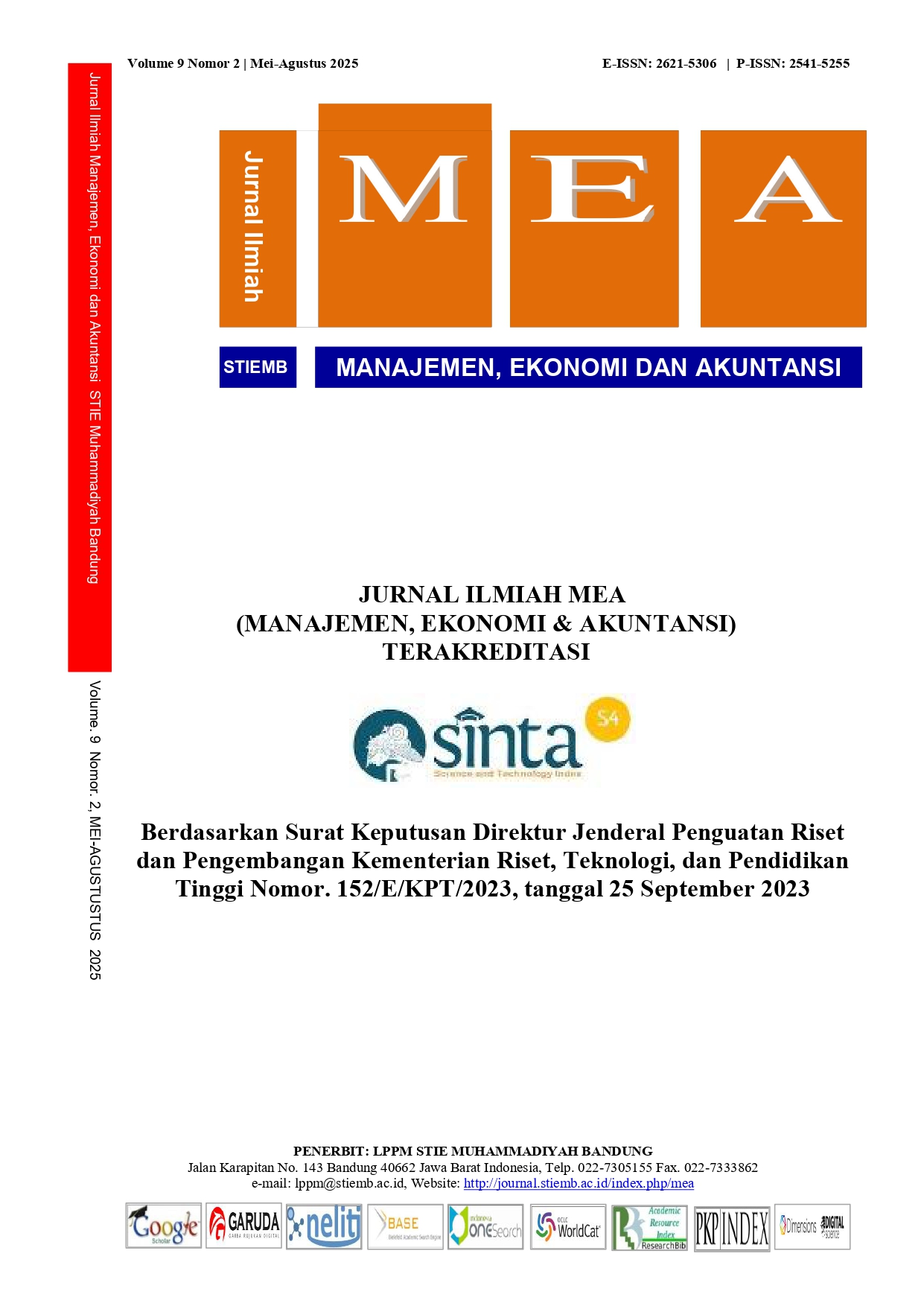STRATEGIC DECISION MAKING FOR ENHANCING PROFITABILITY USING SIMPLE MULTI-ATTRIBUTE RATING TECHNIQUE (SMART) : THE CASE OF LB RESTAURANT
Abstrak
Many restaurant businesses struggled to survive and went bankrupt during the COVID-19 period. LB Restaurant, a food and beverage (F&B) business based in Bandung, Indonesia, faced financial challenges after the COVID-19 pandemic. These challenges arose due to unstable profit growth and increasing, uncontrolled operational costs, which continuously eroded the company’s earnings and resulted in minimal profits. This study aims to identify strategies to improve the profitability of LB Restaurant by utilizing SWOT (Strengths, Weaknesses, Opportunities, Threats) and TOWS Analysis to assess the restaurant’s internal and external factors, based on Common-size Analysis and Profitability Ratio Analysis, the VRIO (Valuable, Rare, Inimitable, Organized) Framework, Value Chain Analysis, and Michael Porter’s Five Forces. Using the SMART method, five alternative strategies: revenue diversification and cost control, maximizing partnerships, digitally enhanced customer retention and social media-driven upselling, financial buffer and contractual safeguards, and streamlined peak-hour operations, were analyzed and prioritized according to the criteria of profit potential, cost potential, customer retention potential, and implementation challenges for each strategic alternative.
Referensi
Alinezhad, A., & Khalili, J. (2019). New Methods and Applications in Multiple Attribute Decision Making (MADM) (Vol. 277). Springer International Publishing. https://doi.org/10.1007/978-3-030-15009-9
Alnsour, M., & Al Faour, H. R. (2022). The Influence of Customers Social Media Brand Community Engagement on Restaurants Visit Intentions. In Research Anthology on Social Media Advertising and Building Consumer Relationships (pp. 1467–1481). IGI Global. https://doi.org/10.4018/978-1-6684-6287-4.ch079
Dimitrova, R. (2015). The influence of external factors on the competitiveness of a company. Zeszyty Naukowe Uniwersytetu Szczecińskiego. Service Management, 16, 37–48. https://doi.org/10.18276/smt.2015.16-04
Edwards, J. B. (2016). Modern Gross Profit Analysis. Journal of Corporate Accounting & Finance, 27(4), 45–55. https://doi.org/10.1002/jcaf.22160
Gagic, S. (2016). Restaurant innovativeness: A case study of Vojvodina. The European Journal of Applied Economics, 13(2), 57–69. https://doi.org/10.5937/ejae13-10503
Isabelle, D., Horak, K., McKinnon, S., & Palumbo, C. (2020). Is Porter’s Five Forces Framework Still Relevant? A study of the capital/labour intensity continuum via mining and IT industries. Technology Innovation Management Review, 10(6), 28–41. https://doi.org/10.22215/timreview/1366
Jogaratnam, G. (2018). Human Capital, Organizational Orientations and Performance: Evidence From the Restaurant Industry. International Journal of Hospitality & Tourism Administration, 19(4), 416–439. https://doi.org/10.1080/15256480.2017.1348920
Kefalas, S. (2019). Quality Service in the Hospitality Industry: Achieving Effective Service Processes and Designs (pp. 39–47). https://doi.org/10.1007/978-3-030-12453-3_5
Khaeruddin, F., Susanti, N. A., & Rahman, Y. (2023). Analisis Rasio Profitabilitas dan Rasio Likuiditas Guna Menilai Kinerja Keuangan. Management and Accounting Research Statistics, 3(1), 59–71. https://doi.org/10.59583/mars.v3i1.19
Morokhovych, V., & Morokhovych, B. (2023). Digital Technologies as an Important Factor of the Restaurant Business Development. Restaurant and Hotel Consulting. Innovations, 6(1), 27–36. https://doi.org/10.31866/2616-7468.6.1.2023.278469
Nagayoshi, S. (2014). How can Company Improve Financial Performance by Learning from Failure? (pp. 333–336). https://doi.org/10.1007/978-3-319-08618-7_32
Nhamo, G., Dube, K., & Chikodzi, D. (2020). Restaurants and COVID-19: A Focus on Sustainability and Recovery Pathways. In Counting the Cost of COVID-19 on the Global Tourism Industry (pp. 205–224). Springer International Publishing. https://doi.org/10.1007/978-3-030-56231-1_9
Niu, B., Li, Q., Mu, Z., Chen, L., & Ji, P. (2021). Platform logistics or self-logistics? Restaurants’ cooperation with online food-delivery platform considering profitability and sustainability. International Journal of Production Economics, 234, 108064. https://doi.org/10.1016/j.ijpe.2021.108064
Penman, S. H. (1991). An Evaluation of Accounting Rate-of-return. Journal of Accounting, Auditing & Finance, 6(2), 233–255. https://doi.org/10.1177/0148558X9100600204
Porter, M. E. (1985). Competitive Advantage: Creating and Sustaining Superior Performance. Free Press. https://books.google.co.id/books?id=cMytzQEACAAJ
Seth, C. (2015). The SWOT Analysis: A key tool for developing your business strategy. 50Minutes.com. https://books.google.co.id/books?id=-NRmCgAAQBAJ
Shin, S., & Cho, M. (2022). Green Supply Chain Management Implemented by Suppliers as Drivers for SMEs Environmental Growth with a Focus on the Restaurant Industry. Sustainability, 14(6), 3515. https://doi.org/10.3390/su14063515
Shubina, S., Miroshnyk, O., Belyaninova, K., & Bieliaiev, A. (2022). ENSURING ACCOUNTING AND ANALYSIS OF REVENUE AND EXPENSES IN THE ENTERPRISE PROFIT MANAGEMENT SYSTEM. Financial and Credit Systems: Prospects for Development, 2, 26–35. https://doi.org/10.26565/2786-4995-2022-2-03
Singgih, E. (2022). PENGARUH RETURN ON ASSET (ROA) DAN RETURN ON EQUITY (ROE) TERHADAP PERTUMBUHAN LABA PADA PT. KALBE FARMA TBK PERIODE 2009 – 2019. Journal Of Communication Education, 16(1). https://doi.org/10.58217/joce-ip.v16i1.253
Taherdoost, H., & Madanchian, M. (2021). Determination of Business Strategies Using SWOT Analysis; Planning and Managing the Organizational Resources to Enhance Growth and Profitability. Macro Management & Public Policies, 3(1), 19–22. https://doi.org/10.30564/mmpp.v3i1.2748
Triono, F., Rahayu, N., & Swantari, A. (2024). Pengaruh Kualitas Produk Terhadap Minat Berkunjung dan Kepuasan Pengunjung Sebagai Variabel Mediasi di Rumah Makan Ampera 2 Tak Veteran Bintaro Jakarta Selatan. REVITALISASI, 13(2), 446. https://doi.org/10.32503/revitalisasi.v13i2.6446
Weihrich, H. (1982). The TOWS matrix—A tool for situational analysis. Long Range Planning, 15(2), 54–66. https://doi.org/10.1016/0024-6301(82)90120-0
Zutter, C. J., & Smart, S. B. (2019). Principles of Managerial Finance, Brief Global Edition. Pearson Education. https://books.google.co.id/books?id=v78oEAAAQBAJ
Zulkarnaen, W., Fitriani, I., & Yuningsih, N. (2020). Pengembangan Supply Chain Management Dalam Pengelolaan Distribusi Logistik Pemilu Yang Lebih Tepat Jenis, Tepat Jumlah Dan Tepat Waktu Berbasis Human Resources Competency Development Di KPU Jawa Barat. Jurnal Ilmiah MEA (Manajemen, Ekonomi, & Akuntansi), 4(2), 222-243. https://doi.org/10.31955/mea.vol4.iss2.pp222-243.
##submission.copyrightStatement##
##submission.license.cc.by-nc4.footer##




















